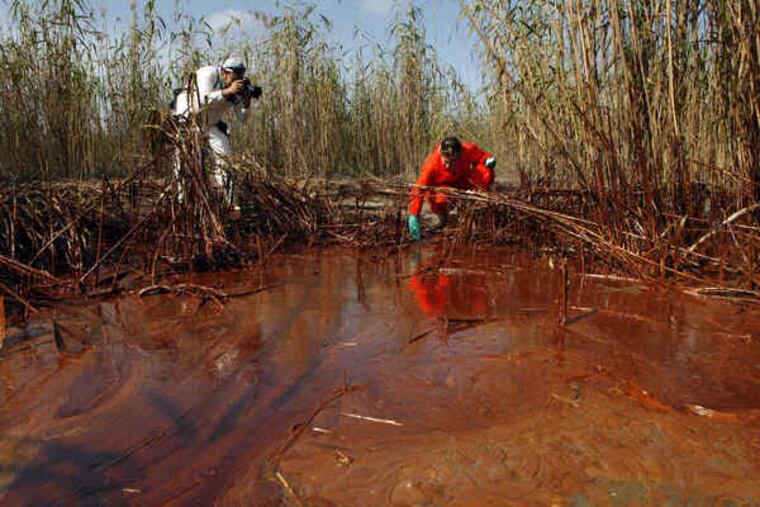BP postpones 'top-kill' effort to cap well
ROBERT, La. - It will be at least Tuesday before engineers can shoot mud into a blown-out well at the bottom of the Gulf of Mexico, BP said Friday in yet another delay in the monthlong effort to stop the oil that is now washing into wetlands and onto at least one public beach.

ROBERT, La. - It will be at least Tuesday before engineers can shoot mud into a blown-out well at the bottom of the Gulf of Mexico, BP said Friday in yet another delay in the monthlong effort to stop the oil that is now washing into wetlands and onto at least one public beach.
A so-called top kill has been tried on land but never 5,000 feet underwater, so scientists and engineers have spent the last week preparing and taking measurements to make sure it will stop the oil that has been spewing into the sea for a month. They originally hoped to try it this weekend.
The White House was expected to announce Saturday that former Sen. Bob Graham of Florida and former EPA Administrator William K. Reilly would lead a presidential commission investigating the spill. The choices were confirmed ahead of time by two people familiar with the decision who would speak only on condition of anonymity.
Graham is a Democrat and Reilly served in a Republican administration, a bipartisan model similar to other high-level investigative panels. The White House has said it was modeling the commission on panels that investigated the 1986 space shuttle Challenger disaster and the nuclear power plant accident at Three Mile Island in 1979.
Graham was in the Senate from 1987 to 2005 and previously served two terms as Florida governor. Reilly was EPA administrator under President George H.W. Bush.
Regarding the latest effort to stop the leak, BP spokesman Tom Mueller said that there was no snag in the preparations, but that the company must get equipment in place and finish tests before the procedure can begin. BP already has three deepwater rigs and other equipment near the blown-out well.
"It's taking time to get everything set up," he said. "They're taking their time. It's never been done before. We've got to make sure everything is right."
Crews will shoot heavy mud into a crippled piece of equipment atop the well, which started spewing after the drilling rig Deepwater Horizon exploded April 20 off the coast of Louisiana, killing 11 workers. Then engineers will direct cement at the well to permanently stop the oil.
BP P.L.C., which was leasing the rig and is responsible for the cleanup, has tried and failed several times to halt the oil.
Chief operating officer Doug Suttles said Friday that a mile-long tube inserted into the leaking pipe is sucking about 92,400 gallons of oil a day to the surface, a figure much lower than the 210,000 gallons a day the company said the tube was sucking up Thursday. Suttles said the higher number is the most the tube has been sucking up at any one time, while the lower number is the average.
The company has conceded that more oil is leaking than its initial estimate of 210,000 gallons a day total, and a government team is working to get a handle on exactly how much is flowing. Even under the most conservative estimate, about six million gallons have leaked so far, more than half the amount spilled by the Exxon Valdez in 1989.
Anger has grown as oil has started washing into delicate coastal wetlands in Louisiana. A deep, stagnant ooze sat in the middle of a particularly devastated marsh off the Louisiana coast.
In Grand Isle, south of New Orleans, officials were forced to close a public beach as globs of oil that resembled melted chocolate washed up.
Oil was hitting in various forms - light sheens, orange-colored splotches and heavier brown sheets - said Chris Roberts, a local official who surveyed the area Friday.